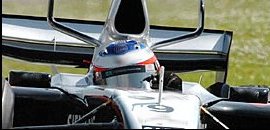Heat ManagementFrom Trackpedia
FadeBrake fade is the reduction in stopping power (i.e. the reduction of friction between the brake pad and the brake rotor or drum) caused by a buildup of heat in the braking surfaces (and in the case of drum brakes the change in dimension of components in response to heat; the curvature of the brake shoes then failing to match the curvature of the brake drum). This reduction of friction can be caused by the gasification of organic materials in the brake pad causing a gas cushion to form between the pad and disk, or by the melting of the binding resins in the pad that then act as a lubricant. The former is most common on new pads and is termed "green fade"; brake manufacturers typically bake new brake linings to minimize green fade. Brake fade usually manifests itself as a noticeable decrease in the stopping force you feel during high speed braking. Typically, the pedal will feel close to "normal" yet the forces of deceleration become less and less both over multiple stops and during the end of a single stop. Fade may or may not be accompanied with a soft or mushy pedal, but that is not directly associated with the loss of friction. It is typically associated with the fluid boiling, pad knock-back or expanding brake lines. A few ways of eliminating or reducing fade are:
Boiled FluidBrake fluids for the track are generally designed with high boiling points relative to fluids for the street. However, depending on your application, you may find that you still exceed the boiling point from time to time. Typically, heat is transferred through the pads, through the caliper pistons and into the calipers where the fluid resides. If the fluid reaches its boiling point, gas bubbles will be introduced into the system. Since a gas is many orders of magnitude more compressible than a liquid, this causes a loss of firmness in the pedal and if bad enough, may make it impossible to reach the minimum required line pressure to activate the brakes sufficiently. Some ways of dealing with brake fluid boiling:
Brake ShimsBrake shims are thin pieces of metal that do not conduct heat that are placed between your brake pads and the calipers. Hard Brakes (formerly TiSpeed Braking) manufactures titanium alloy brake shims that are designed to provide a final thermal barrier between the friction-generated heat from your brakes and your brake boots and fluids. The titanium alloy is chosen to provide maximal thermal barrier in a lightweight and thin form factor that can be used even with new brake pad applications. Titanium provides much better thermal protection than stainless steel or other conventional brake shim materials. Titanium components are used in a similar fashion for major racing platforms in F1 and NASCAR, and in top-end racing calipers from Brembo. These heat shields are available for a wide range of track cars and racing calipers. DuctingPlease add pictures and descriptions of your innovative ducting solutions! |

